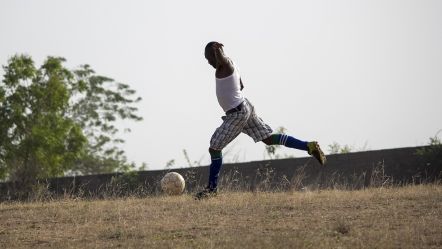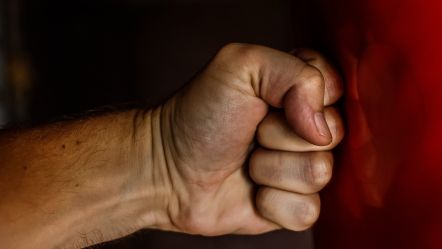Safe sport
The protection of athletes is a key element of the European Sports Charter, the Code of Sport Ethics and specific sport related recommendations of the Council of Europe.
Therefore, the Enlarged Partial Agreement on Sport (EPAS) organises events and implements projects to raise awareness on safe and healthy sport environments and to promote the well-being of those who practice sport.

Safety, Security and Service

The Council of Europe Convention on an Integrated Safety, Security and Service Approach at Football Matches and Other Sports Events (CETS No. 218) entered into force on 1st November 2017 after having been ratified by three Member States of the Council of Europe: France, Monaco and Poland.
This convention builds upon knowledge and experience accumulated at international level by the Standing Committee of the European Convention of Spectator Violence , which was the first pan-European institutional treaty reacting to the Heysel tragedy in 1985 designed to tackle the so-called phenomenon of European hooliganism. Today, the principal aim of this convention is to go from a violence-focused approach towards an integrated approach based on three independent pillars: safety, security and service.
The sports world has undergone ever increasing changes over the last thirty years, impacting the way in which sports events are organised. With more ways to follow, watch and engage with these events, we can say that from a fan’s point of view, they have evolved from a mere sporting event to an “experience”.
There has been a growing number of high profile European matches, wider media coverage, bigger interaction via social media, and as travelling has become much easier and more affordable, there is a higher number of supporters travelling around Europe, leading to an expansion in popularity of public viewing areas, fans zones, etc.; it was clear that all of these new challenges have to be addressed. With all of this in mind, the Council of Europe has elaborated a convention, based on the best European practices gathered over 30 years.
Did you know?
The two main characteristics of this convention are:
- the integrated approach: safety, security and service are considered as three interdependent pillars: safety, security and service measures cannot be implemented in isolation and security should never overrule safety and service;
- the multi-agency approach means that a range of agencies or stakeholders must be involved in the safety and security of a sports event and that no single stakeholder, e.g. the police, can address this issue alone.
This convention is the only internationally binding instrument to establish an integrated approach based on safety, security and service. It also promotes co-operation between all public and private stakeholders: governments, municipal authorities, police, football authorities and also supporters, in order to provide a safe, secure and welcoming environment at football matches and other sports events, whether it be inside or outside the stadia.
It was opened for signature on 3 July 2016 in Saint-Denis (France), at a UEFA EURO 2016 quarter-final match and has been already ratified by 31 countries and signed by 8 (as at the end of January 2025). Furthermore this convention has a global purpose and can be ratified by any state worldwide.
As soon as ten countries will have ratified this convention, a Committee on Safety and Security at Sports Events will be set up. It will progressively take over the Standing Committee’s activities of standard-setting, monitoring and technical assistance, and would also become the expert platform for international co-operation in this field.
Do you know the difference between safety, security and service?
The concept of safety gathers all measures related to the protection of people from being injured or facing a risk to their health and well-being during sport events. This comprises stadium infrastructures and certification and contingency plans.
The concept of security incorporates all measures designed to deter, prevent and sanction any incident of violence or misbehaviour in connection with football or other sport events. It includes, in particular, risk assessment, co-operation between police and other relevant agencies and the establishment of sanctions.
The concept of service comprises all measures designed to make football and other sport events enjoyable and welcoming for all, in stadiums but also in public spaces where spectators and supporters gather before, during and after the matches. This incorporates material elements like good catering and toilet facilities; but, above all, it focuses on the manner in which people are greeted and treated throughout the event.
Updated Chart of signatures and ratifications
Good practices to implement the Convention

Inclusion of children and their protection in sport

This theme was first broached by the Enlarged Partial Agreement on Sport (EPAS) in 2013 with an annual conference held in Budapest (7-8 October 2013), co-organised with the Hungarian Secretariat of Sport, and in co-operation with the Council of Europe’s ONE in FIVE Campaign to stop sexual violence against children.
It addressed two main issues: the inclusion of children in vulnerable situations in sport so that they can take advantage of the benefits which sport offers and the protection of children against sexual harassment in sport, including a Q&A session and panel discussion with Patrik Sjöberg, former World High-jump Champion.
Following on from this, EPAS co-financed and implemented a joint project with the EU (under Erasmus+ funding) from 20114-2015 which was titled "Pro Safe Sport" (PSS) and which was aimed at promoting a safe and healthy environment for young athletes. Thanks to this initial PSS project, the PSS Online Academy showcases how stakeholder organisations can design, implement and evaluate safe sport policies and projects.
It was then followed up in 2017 by a new 9-month joint initiative: "Pro Safe Sport +" (PSS+) (running from 1 April to 31 December) and which focused solely on sexual violence against children in sport. One result of this project was the "Start to talk" initiative.
From March 2020 to June 2022, the EU-CoE joint project "Child Safeguarding in Sport" (CSiS) aimed to support partner countries in the setting up of Child Safeguarding Officers in sport, through a tailor-made, collaborative methodology adapted to their national context. These contact persons are trained, equipped and integrated into a European network where they can continue to exchange and learn from their peers.

Protection of young athletes from dangers linked to migration

The Council of Europe is helping to combat the trafficking of young footballers from other continents to Europe. Every year hundreds of them are lured to European cities by false promises of glittering careers with top clubs.
The reality is that they are often abandoned soon after arriving, and left to fend for themselves.
In 2012, the Committee of Ministers adopted its recommendation on the subject, the drafting of which was co-ordinated and carried out by the EPAS member states.
A report for Euronews on the subject includes interviews with victims as well as those trying to help them.

Extreme martial arts and combat activities

In 1999, the Committee of Ministers of the Council of Europe adopted a recommendation concerning the “the prohibition of free fighting contests, such as cage fighting”. Society and the practice of such activities have evolved greatly since then and so EPAS has again taken up this issue in 2014.
Initially, on the basis of replies received from member states to a questionnaire and a round table discussion in 2014, a new debate with experts within the Governing Board of EPAS on the subject led to a factsheet being drawn up on the nine most important issues highlighted. This resulted in EPAS concluding an in-depth study with experts in 2017 in a working group format, and notably interviews with numerous actors in this field. The mandate given to this working group was to prepare the elements for a possible new recommendation on the matter. The final draft of the new recommendation and its explanatory memorandum were approved by the EPAS Governing Board during its meeting in September 2020.
Then, on 31 March 2021, the Committee of Ministers adopted the Recommendation to its member States on extreme martial art and combat activities (CM/Rec(2021)3). The new recommendation focuses on those aspects which can significantly help to prevent risks to the health of the practitioners, so that these activities are in keeping with the requirements of existing norms with regard to the values of sport, the prevention of doping and the manipulation of sports competitions, fair competition and the training of coaches and referees.
The main stakeholders who are asked to take action include governments’, (recognised) sports organisations, ad hoc bodies for the regulation of Extreme Martial Arts and Combat Activities, such as national platforms, authorities, working groups, as well as commercial organisations organising extreme martial arts and combat activities.
The recommendation sets the aims, calls for multi-stakeholder co-operation and invites EPAS to follow up and facilitate co-operation.
It is completed by Guidelines which outline the key areas covered by the recommendation and specify the role expected from the various stakeholders. It replaces the above-mentioned Committee of Ministers’ Recommendation R(99)11 which was on the prohibition of free fighting contests such as cage fighting.
Recommendation (CM/Rec(2021)3) and its Appendix (Guidelines)
Explanatory Memorandum (CM(2021)30-addfinal)



